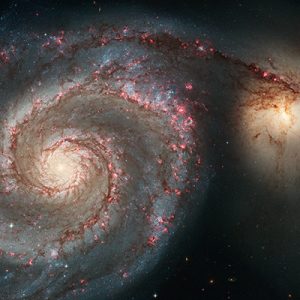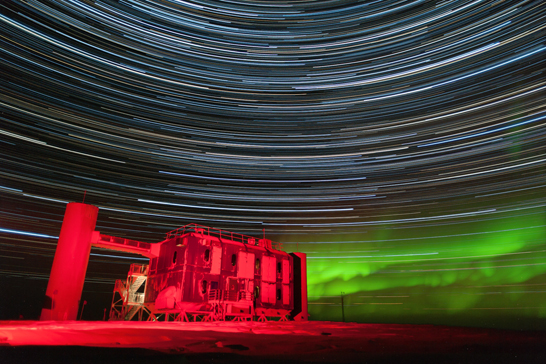
The astronomy and astroparticle group consists of eight research faculty and two teaching faculty. The astronomy research group focuses predominantly on extragalactic and stellar astronomy, with approximately equal emphasis on theory and observation. The astroparticle research group focuses on the IceCube neutrino observatory and the VERITAS gamma ray observatory. Active research areas include the following:
- Galaxy morphology, disks, and resonance phenomena (Dr. Preethi Nair),
- Galaxy interactions, galaxy evolution, and AGN (Dr. Preethi Nair, Dr. Jimmy Irwin)
- Galaxy formation simulations (Dr. Jeremy Bailin)
- Galaxy halos — observations and simulations (Dr. Jeremy Bailin)
- Stellar populations in nearby galaxies and globular clusters (Dr. Jeremy Bailin, Dr. Preethi Nair)
- Observational and theoretical study of hot gas in galaxies and clusters of galaxies (Dr. Jimmy Irwin, Dr. Ray White)
- Observational study of neutron stars and black holes (Dr. Jimmy Irwin).
- Theoretical study of white dwarfs accretion and SNe explosions (Dr. Dean Townsley).
- Theoretical study of planet formation and its implications for exoplanetary sciences and our Solar System (Dr. Chao-Chin Yang).
- Astrophysical neutrinos at TeV-PeV energies from AGN or gamma ray bursts (Dr. Dawn Williams, Dr. Marcos Santander)
- Multi-messenger astronomy (neutrinos, cosmic rays, gamma rays, and gravitational waves) (Dr. Dawn Williams, Dr. Marcos Santander)
Our faculty and their current research interests are:
Dr. Jeremy Bailin is a theoretical and observational astrophysicist investigating the nature of galaxy formation, studying how the nearly uniform Universe that existed after the Big Bang transformed over almost 14 billion years into galaxies like the Milky Way. Dr. Bailin is particularly interested in the structure and history of spiral galaxies, their dark matter, stellar, and gaseous halos, and their satellites — small dwarf galaxies and globular star clusters that orbit far from the galaxy.
Dr. Jimmy Irwin uses X-ray satellite observatories to investigate the nature of galaxies, clusters of galaxies, and compact stellar remnants (neutron stars and black holes) accreting matter from neighboring stars in binary stellar systems. Current and recent research projects include: (i) identifying high mass concentrations on the galaxy or group scale with gravitational lensing; (ii) searching for evidence for intermediate-mass black holes (IMBHs) in globular clusters from the tidal disruption of passing stars in the cluster; (iii) the flow of gas within the Bondi radius of a supermassive black hole.
Dr. Preethi Nair is an observational astronomer whose research focuses on large surveys to investigate the formation and evolution of galaxies. Dr. Nair works on characterizing the detailed morphologies of galaxies to determine the growth of structure (bulges, bars, rings, spiral arms) in galaxies and to determine the role of these structures in the mass, metallicity, star formation and AGN triggering histories of galaxies. Dr. Nair is also interested in blackhole occupation fractions in galaxies to constrain SMBH models. Dr. Nair is part of the Sloan Digital Sky Survey-IV and is working with the IFU survey MaNGA which will provide resolved spectroscopy of 10,000 galaxies in the nearby Universe.
Dr. Dean Townsley is a theoretical astrophysicist whose research interests lie in refining stellar physics via its application to novel and dynamic astrophysical systems. More specifically, he studies white dwarf stellar remnants accreting mass from a companion in close stellar binaries. Current research interests include (i) deriving general properties of the compact stellar binary population; (ii) hydrodynamic simulations to study the explosive nuclear events which occur in accreting white dwarf binaries, including surface runaways (Classical Novae) and thermonuclear supernovae (Type Ia).
Dr. Ray White uses X-ray satellite observatories to study the hot atmospheres of elliptical galaxies, as well as galaxy groups and clusters. He uses X-ray spectroscopy to determine the gas temperatures and chemical abundances in these atmospheres, in order to help determine how galaxies and clusters evolve. More specifically, Prof. White uses X-ray observations to determine how much mass galaxies lose to their environment and to constrain theoretical models of supernovae (exploding stars), which enrich the atmospheres of galaxies and galaxy clusters
Dr. Chao-Chin Yang is a theoretical astrophysicist studying how planets were assembled from their natal circumstellar disks to form our Solar System and thousands of extrasolar planetary systems detected in the past couple of decades. He specializes in magneto-hydrodynamics and dust-gas dynamics of circumstellar disks and the formation of kilometer-sized planetary objects such as asteroids and Kuiper Belt objects in the Solar System. His investigation usually involves large-scale computer simulations on high-end computing clusters and the ensuing data analysis.
In addition to the faculty mentioned above, the following faculty contribute to the astronomy group
Dr. Sergei Gleyzer, an experimental particle physicist working with the CERN CMS experiment. His research interests include pure machine learning and computer science theory of optimization, particularly by automatic feature extraction and breaking down the learning algorithms to their most basic pieces and finding ways to optimize them. His group has applied this work to many astronomy projects including studying dark matter via strong gravitational lensing, exoplanet detection, etc.
Dr. Julia Cartwright, an assistant professor in the Department of Geology, studies meteorites to better understand the formation and evolution of our Solar System.
Dr. Murray Silverstone is a teaching faculty in the Department of Physics and Astronomy with expertise in planet formation, specifically with circumstellar disk detection & imaging.
Emeritus Faculty
Dr. Bill Keel‘s research is broadly centered on the evolution of galaxies, including studies of galaxies and groups at high redshifts, ultraviolet studies of nearby galaxies as points of comparison for objects seen at higher redshift and – in collaboration with Professor White – using the backlighting afforded by overlapping galaxy pairs to measure the effects of dust in spiral galaxies. Prof. Keel is a member of the Galaxy Zoo team and is leading follow-up observations of Voorwerp objects which display quasar ionization echoes. He is also the UA coordinator for participation in the SARA observatory consortium.
Dr. Ron Buta‘s research concerns the morphology and dynamics of barred and oval disk galaxies. He is particularly interested in the evolution of such galaxies and the role the bar plays in generating structure. For the most part, Professor Buta’s approach has been observational, and he has used data obtained in ultraviolet, optical, near-infrared, and 21-cm radio wave bands for studying galaxies. He has also conducted numerical simulations of several well-observed nearby barred galaxies, using near-infrared images to define the gravitational potential. He has also been involved in the construction of large galaxy catalogues.
Major Astronomy Collaborations and Resources
- SARA Observatory consortium
(telescopes at Kitt Peak, AZ & Cerro Tololo, Chile) - Galaxy Zoo
- Sloan Digital Sky Survey IV
The astronomy group also uses the high-speed computing facilities of the Alabama Research and Education Network in Huntsville are available.
Astronomy group members are regular users of NASA satellite observatories (Hubble, Chandra, XMM-Newton, GALEX, Swift, Suzaku) and ground-based telescopes worldwide. Research is supported by the NSF and NASA.
Particle Astrophysics
The astroparticle group consists of two research faculty, one teaching faculty, and one visiting faculty.
- IceCube Neutrino Observatory (Antarctica)
- VERITAS Gamma Ray Observatory (Arizona)

Dr. Dawn Williams research area is particle astrophysics — using measurements of neutrinos, cosmic rays, and gamma rays from outside the solar system to explore the high energy universe. Dr. Williams is involved in various aspects of calibration of large volume neutrino telescopes. She is a member of the IceCube Neutrino Observatory, IceCube-Gen2, and the Radio Neutrino Observatory — Greenland (RNO-G) collaborations. Dr. Williams is the co-convenor of the IceCube Neutrino Observatory calibration working group, the Level 2 Lead for Calibration and Characterization for the IceCube Upgrade project, and the Level 2 Lead for Detector Calibration and Commissioning for IceCube-Gen2.
Dr. Marcos Santander is interested in multimessenger astrophysics, combining observations of high-energy neutrinos and gravitational waves with those collected by gamma-ray and X-ray telescopes to study some of the most powerful objects in the Universe, in particular active galactic nuclei. His group is involved in the IceCube neutrino telescope and the VERITAS gamma-ray telescope array, as well as in the development of two next-generation, ground-based gamma-ray observatories: CTA and SWGO. The group also leads observational programs using space-based instruments such as the Fermi gamma-ray space telescope, and the Swift, NICER and NuSTAR X-ray telescopes.
In addition to the faculty mentioned above, the following faculty contribute to the astroparticle group
Dr. Nobu Okada, a theorist, is investigating signals for new physics at the Large Hadron Collider and in astrophysical observations.
Dr. Patrick Toale is a teaching faculty in the department of Physics and Astronomy with expertise in particle astrophysics.
Adjunct Prof. Biermann is active in high-energy astrophysics, particularly in theoretical studies of cosmic rays and active galactic nuclei.
Contact Us
If you are a student (undergraduate or graduate) with a possible interest in astronomy or astroparticle physics we would be glad to hear from you via e-mail or otherwise. Please contact one of the physicists above or email physgrad@ua.edu for information about graduate study. Information about our graduate program is also available on our website.